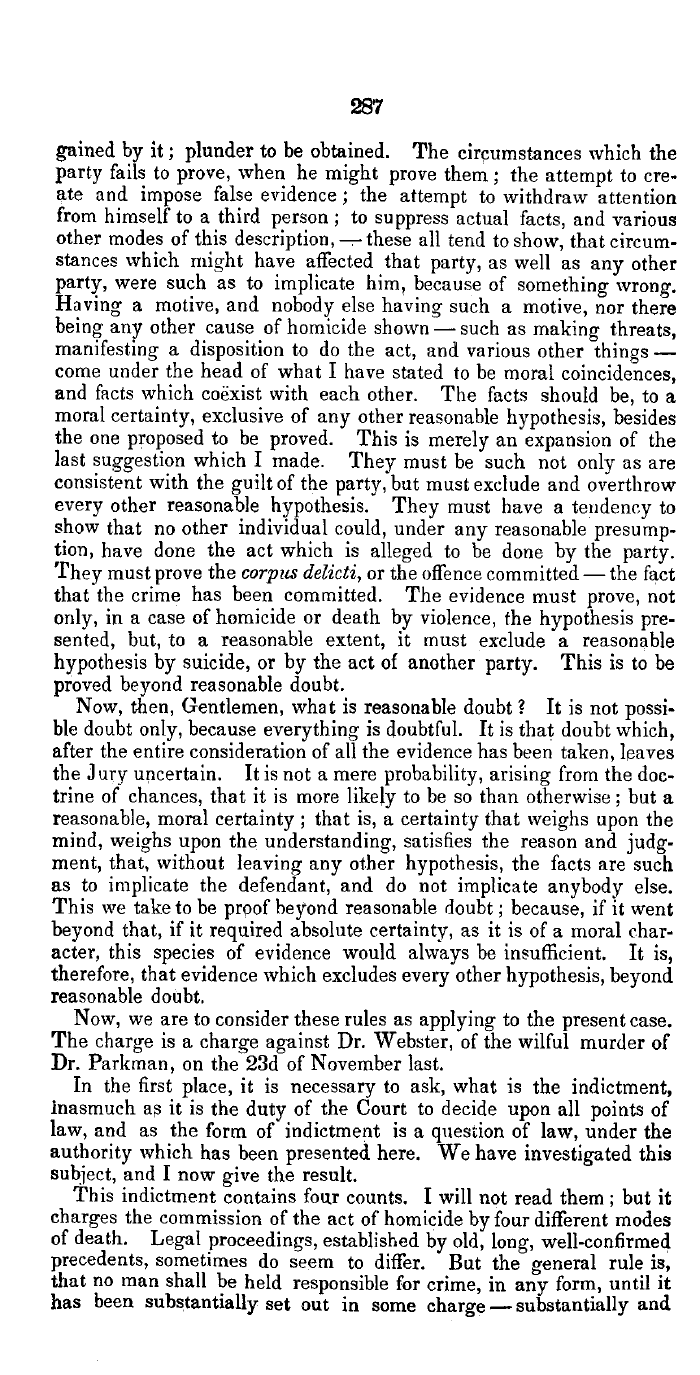|
287
gained by it; plunder to be obtained. The circumstances which the
party fails to prove, when he might prove them ; the attempt to cre-
ate and impose false evidence ; the attempt to withdraw attention
from himself to a third person; to suppress actual facts, and various
other modes of this description,-these all tend to show, that circum-
stances which might have affected that party, as well as any other
party, were such as to implicate him, because of something wrong.
Having a motive, and nobody else having such a motive, nor there
being any other cause of homicide shown-such as making threats,
manifesting a disposition to do the act, and various other things -
come under the head of what I have stated to be moral coincidences,
and facts which coexist with each other. The facts should be, to a
moral certainty, exclusive of any other reasonable hypothesis, besides
the one proposed to be proved. This is merely an expansion of the
last suggestion which I made. They must be such not only as are
consistent with the guilt of the party, but must exclude and overthrow
every other reasonable hypothesis. They must have a tendency to
show that no other individual could, under any reasonable presump-
tion, have done the act which is alleged to be done by the party.
They must prove the corpus delicti, or the offence committed-the fact
that the crime has been committed. The evidence must prove, not
only, in a case of homicide or death by violence, the hypothesis pre-
sented, but, to a reasonable extent, it must exclude a reasonable
hypothesis by suicide, or by the act of another party. This is to be
proved beyond reasonable doubt.
Now, then, Gentlemen, what is reasonable doubt? It is not possi-
ble doubt only, because everything is doubtful. It is that doubt which,
after the entire consideration of all the evidence has been taken, leaves
the J ury uncertain. It is not a mere probability, arising from the doc-
trine of chances, that it is more likely to be so than otherwise; but a
reasonable, moral certainty ; that is, a certainty that weighs upon the
mind, weighs upon the understanding, satisfies the reason and judg-
ment, that, without leaving any other hypothesis, the facts are such
as to implicate the defendant, and do not implicate anybody else.
This we take to be proof beyond reasonable doubt; because, if it went
beyond that, if it required absolute certainty, as it is of a moral char-
acter, this species of evidence would always be insufficient. It is,
therefore, that evidence which excludes every other hypothesis, beyond
reasonable doubt.
Now, we are to consider these rules as applying to the present case.
The charge is a charge against Dr. Webster, of the wilful murder of
Dr. Parkman, on the 23d of November last.
In the first place, it is necessary to ask, what is the indictment,
Inasmuch as it is the duty of the Court to decide upon all points of
law, and as the form of indictment is a question of law, under the
authority which has been presented here. We have investigated this
subject, and I now give the result.
This indictment contains four counts. I will not read them ; but it
charges the commission of the act of homicide by four different modes
of death. Legal proceedings, established by old, long, well-confirmed
precedents, sometimes do seem to differ. But the general rule is,
that no man sball be held responsible for crime, in any form, until it
has been substantially set out in some charge -substantially and
|

